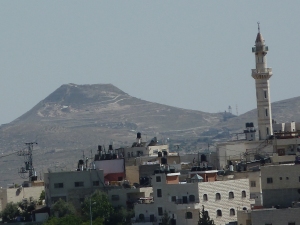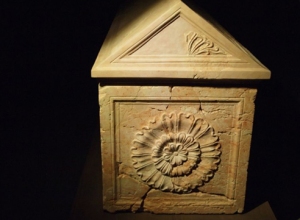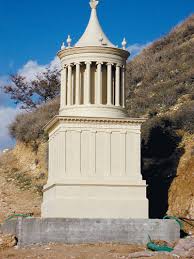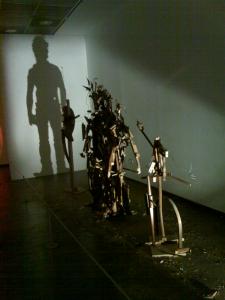It’s been quite a while since I last visited the Israel Museum and, to tell the truth, I would not normally have chosen an afternoon in late August, during the school holidays, when the museum opens its doors free to children. However, a guided tour of the exhibition “King Herod’s Final Journey”, organized by the Jerusalem District Committee of the Israel Bar Association, was too good to miss. The exhibition, the most expensive and carefully planned in the Museum’s history, was originally envisaged by the late Prof. Ehud Netzer, who discovered the long-sought-for tomb of Herod the Great in 2007, on the man-made mountain which bears the name of that most controversial of Judaean monarchs, Herodium (or Herodion).
Situated on the edge of the Judaean Desert, south of Jerusalem and east of Bethlehem, Herodium is clearly visible from my living room window.
The exhibition is dedicated to the memory of Prof. Netzer, who was fatally injured in 2010, when a railing at the dig site gave way and he fell 6 metres, suffering head and neck injuries. He died three days later.
It is perfectly possible, said our guide, to see the entire exhibition in half an hour, but, she added, she could talk for three hours about King Herod. And she did – almost. She had brought with her a copy of Josephus’s “The Jewish War”, from which she read, with great histrionic talent, relevant passages, describing Herod’s cruelty, his crimes and his exceedingly unpleasant death from an unnamed illness (which, according to her, was probably syphilis – although many other theories have been advanced).
Not all the exhibits came from Herodium. The exhibition is planned as if the visitor is following the route of Herod’s funeral cortege, from the throne-room at his winter palace in Jericho, through the Judaean desert to Jerusalem. On the way, we are shown relics from other archaeological sites connected with the King, who was famous, amongst other things, for his building projects, the best-known of which was the Temple Mount Complex in Jerusalem.
Herod did not build the Second Temple. That was carried out by the Jews who returned from the Babylonian Exile, under Zerubbabel, Ezra and Nehemiah. However, this Temple was small and built entirely of wood, unlike its magnificent predecessor, built by King Solomon. So, whether to placate his Jewish subjects, who did not take kindly to the rule of the usurper forced upon them by the Romans, or whether for his own aggrandizement, Herod conducted a massive programme of renovation which, to all intents and purposes, involved pulling down and completely rebuilding the Temple Complex. In order to do so, Herod’s architects and builders doubled the size of the Temple Mount by means of a massive landfill, which was supported by huge retaining walls. The wall we know today as the Western (or Wailing) Wall is, in fact, one of these retaining walls. Deprived of the right to pray on the Temple Mount itself, by successive occupying powers, and now denied that right even by the Israeli Government, so as not to provoke the Muslims, over the centuries, the Western Wall became the focus of a nation’s prayers.
Photography is forbidden at the exhibition, but there was one exhibit I simply had to photograph – a stone bearing the inscription: “To the place of blowing the trumpet” (לבית התקיעה – lebeit hatkiyah). This stone was discovered at the corner of the Western and Southern Walls of the Temple Mount, exactly where it was hurled by the Romans, when they destroyed the Temple two thousand years ago. And what was this “Place of blowing the trumpet”?
Our sages tell us that, on the eve of the Sabbath, one of the priests would sound six blasts on the shofar, to give notice of the impending start of the Day of Rest. First, he would blow once, to give sufficient warning to the workers in the fields that the Sabbath was approaching so as to enable them to get home in time for the Sabbath. After a lapse of time, he would sound the horn once again, to alert the shopkeepers and others living and working in the city that it was time to shut up shop and head for home, to prepare to welcome the Sabbath. The third blast of the shofar was to let the women know that the time had come to cease their housework and prepare to light the Sabbath candles. Shortly after this, the priest would sound Tekiyah, Teruah, Tekiyah in succession to announce the start of the Sabbath.
In many towns and villages in modern Israel, which are far too large for a single shofar to be effective, the approach of the Sabbath was announced by sirens. But lately, this custom has become less and less common, probably because of the psychological effect of the noise of air raid sirens on citizens who have, of late, had to become all too used to the sound which most of them now associate with incoming missile attacks from our delightful neighbours, Hamas and the Islamic Jihad in Gaza, and Hezbollah in the Lebanon.
At any rate, prohibition or no, I could not resist photographing this proof of the existence of a Jewish Temple on the site of the Temple Mount, especially in light of the current Muslim myth denying the existence of any Jewish presence there.
The highlight of the exhibition is the reconstruction of the Mausoleum itself. This monument to Herod’s hubris was smashed to pieces, apparently by the Zealots who captured Herodium during the Great Revolt (66-70 C.E.) and wanted to erase all memory of the hated ruler.
Even without the prohibition of photography at the exhibition, it would have been impossible to get a clear shot of the reconstructed tomb, due to the sheer numbers of visitors milling around, so the pictures you are now going to see, of the mausoleum and the royal sarcophagus, are not my own.
By the time the guided tour ended, it was almost 8 pm. With an hour to go until closing time, I decided to go and see an exhibition constructed around the “Gabriel Stone“, so called because it describes an apocalyptic vision of an attack on Jerusalem, in which God appears, accompanied by angels, chief of whom is Gabriel, to save the city.
Arranged around the stone are ancient Christian and Muslim manuscripts, all relating to the Archangel Gabriel, who plays an important role in both these religions. For Christians, it is Gabriel who appeared to the Virgin Mary and predicted the birth of her son, Jesus. For Muslims, it was Gabriel (or Jibril, as he is known in Arabic) who revealed the word of Allah to the Prophet Muhammed.
This is quite a small exhibit, so, after that, I made my way to the Youth Wing of the museum, where our guide had recommended an exhibit entitled “Illusions”, or ArTricks. This was an exhibit devoted to optical illusions and included works by Escher, an infinite mirror, a “painting” of a bird falling into water so realistic, you can actually see the splash as it hits the water’s surface, and Tim Noble and Sue Webster’s light and shadow display, of discarded pieces of wood, arranged in such a way that when a light projector is placed behind it, the shadow of a young man appears on the wall.
Illusion occurs when the brain “corrects” the image transmitted by the eye on the basis of its past experiences and memories, thus creating the illusion that the image we perceive actually exists in reality. (Perhaps herein lies the explanation for some of the defamatory and outrageously false statements made about Israel by her detractors. They believe what they want to believe, see what they expect to see, in light of their already existing prejudices.)
When I left the museum at about twenty to nine, people were still arriving! That includes parents with children in push-chairs. And, much as I hated the crowds, it gives me a wonderful feeling to know that, in Israel, among the People of the Book, families still feel that an outing to a museum is a cool thing to do during the summer vacation 🙂
Shabbat Shalom to you all from Jerusalem.








I love this post! I almost felt I was back in the city! It amazes me how people choose to believe the muslim myth!!
I’m glad you felt that way, about being back in Jerusalem. I thought that, over what’s left of the summer, I might do a few more “travel” pieces, for people who would like to visit, but for some reason, cannot.
More acts of robbery committed by you people against the Palestinians. These excavations were carried out in the Occupied Territories and the artefacts were stolen from the Palestinian People, in defiance of international law.
The curator of the exhibition has actually stated that, at the end of the exhibition, all the artefacts will be returned to their owners. As for those artefacts, from Herodium, the question as to whether Herodium will be included within the borders of a Palestinian State at some future date is a matter for negotiation between Israel and the “Palestinians”. As things stand, however, given the reckless way the Muslim Waqf dug up and threw away countless Jewish relics when they illegally carried out excavations on the Temple Mount, in order to expand the mosques and turn Solomon’s Stables into yet another mosque, and even deliberately obliterated evidence of the existence of our Temple there, it is perhaps fortunate that we excavated the Herodium site before the “Palestinians” could get their hands on it. They show little respect for the archaeological remains of any people other than themselves.
BTW, Greta – are you also in favour of returning the Elgin Marbles to Greece, the Siloam Inscription to Jerusalem, and the countless Egyptian, Asian, African and Native American artefacts stolen by Europeans and North Americans to fill the world’s great museums, to their countries of origin?
Greta, you are full of fertilizer! At least that would explain your fertile imagination.
The Temple Mount was not stolen from the “Palestinian People” because it never belonged to them in the first place. It was a site that the Jews regarded as holy 3000 years ago. Some sixteen centuries after that, the so-called “prophet” Mohammed had a dream that he ascended to heaven from there and after his death, his mentally-deranged terrorist followers conquered the site and desecrated it with their mosques. At the time, they at least retained a small kernel of decency and didn’t try to rewrite history. Now the modern Moslems are discarding what little decency the early followers of Mohammed had and are trying to claim that it was never Jewish in the first place.
It was the Moslems who excavated under the Temple Mount and threw away items of Jewish history in an act of vandalism characteristic of the Moslems. Now it has been liberated from the savages who occupied it and denied Jews access to it and they will never have it again.
Unfortunately, while Jews now have access again to the Temple Mount, we are still not allowed to pray there.
Daniel,You and I may think that one tower was enough, but Josephus wrote that the Herodian Antonia had four towres at each corner (War 5.238-246). I placed the southwest tower above the rockscarp at the end of the Western Wall, which can be seen inside the Temple Mount.I have written that the early Antonia which replaced the Hasmonean Baris stood at the northwest corner of the 500 cubit square pre-Herodian Temple Mount, which indeed had a counterpart in the northeast tower mentioned as the aliyat hapina in Neh. 3.31.The Double and Triple Gates are mistakenly identified as the Huldah Gates. The real Huldah Gates are mentioned only in Mishnah Middot and refer to the southern gates in the pre-Herodian square Temple Mount. The historical names of the Herodian Double and Triple are not known.
Beautiful description of the six shofar blasts, Shimona. Thank you for that! I, too, enjoy going along with you on these tours. I learn so much! As you’d stated in the last paragraphs of your post, “Palestinians” and their supporters see what they choose to see. Greta’s response to your post today bears that out completely. You could not have had your point more fully or eloquently illustrated.
Chrissie, I’m glad you enjoyed the “virtual tour”. As I told Carolyn, I’m planning some more, as I can see my readers enjoy them.
Yes, Greta does seem to suffer from tunnel-vision where Israel and the “Palestinians” are concerned.
PS. Is Angus Mhor still with you? Is he well?
Shimona,
Angus Mhor IS alive and well. Earlier this morning, he lay behind me on the back of the couch and put his paws on my right shoulder, resting his head next to my cheek. At the age of 8 years he remains a cheeky bloke and a perfect love. Hale, healthy and hilarious, he is mostly wherever I am, and should I be to-ing and fro-ing throughout the house, he hides behind corners to whap my calf as I buzz by, eliciting a squeal. Squinching his eyes shut in his smug superiority, he quickly plots his next move. I, adrenaline soaring and breathless with laughter, pretend blindness to his entrapment. It is a game we both enjoy!
Shalom, my Over-the-Sea Friend.
Trixie and Caspurr are very glad to hear that. However, we think that, when he squinches his eyes shut, he may possibly be “engaged in a rapt contemplation,Of the thought, of the thought, of the thought of his name:His ineffable effable Effanineffable, Deep and inscrutable singular Name“, rather than plotting his next move 🙂
Does he no longer blog?
“Solomon’s Stables” had nothing to do with Solomon.They were built by the crusaders who persecuted Jews as well as Muslims.
They were named “Solomon’s Stables” by the Crusaders, but the Crusaders did not build them. They are much older, although some scholars date them to the time of the Roman Emperor Hadrian, rather than to Herod. It is possible that the basic structure is Herodian, and that further renovations were carried out later. Herodian masonry has been found there and the Triple Gate passageway of the Huldah Gates, forms the western boundary of the “Stables”.
The damage caused by the Waqf, during the course of converting this ancient structure into a mosque, with the subsequent destruction and loss of so much archaeological evidence, is probably irreparable.
It is true that the Crusaders persecuted – nay, massacred – Jews as well as Muslims. It is also true that Jews and Muslims in Jerusalem fought shoulder to shoulder against their common enemy.
I enjoyed reading your very informative and attractive post here, including the pictures which really brought the subject to life. You’ve managed to cover a lot, while being exact on historical issues. I had the pleasure of working with Prof. Netzer some years ago, and I’m sure that there are many who knew him, who sense a great tragedy in the way his life ended. Still, his work continues to live, and many who did not have the pleasure of listening to him speak of our history, will be able to enjoy some of his findings.
I’m glad you enjoyed it, Shimon. Did you actually take part in any archaeological excavations with Prof. Netzer? There is something about digging up our people’s history, which goes beyond the ordinary excitement of discovery, I think. I remember taking part in the digs to the south of the Old City when I was a young student (I can’t remember exactly where, I think the Ophel) and it was such a thrill.
I wish I had been privileged to meet Prof. Netzer. It was a great tragedy the way his life ended. On the other hand, at least he knew, before he died, that he had made the discovery of a lifetime, and had unearthed the site for which he had been searching for 4 decades.
Pingback: Herod’s Last Journey * | News and Views from Jews Down Under
Pingback: Herodion: Herod’s Fortress-Tomb | THE VIEW FROM THE PALACE